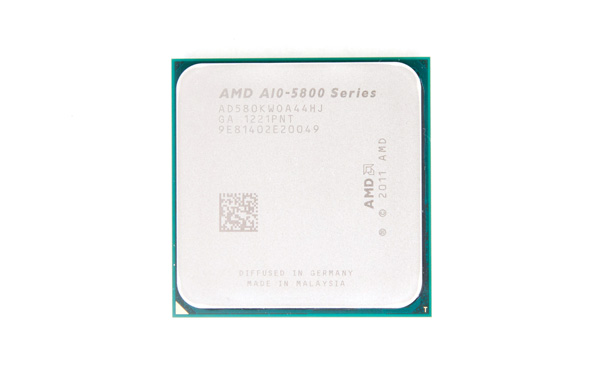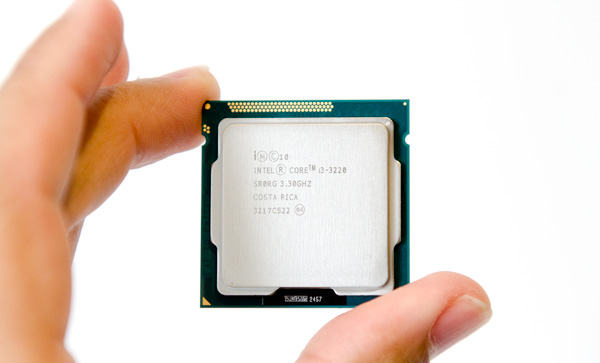AMD A10-5800K & A8-5600K Review: Trinity on the Desktop, Part 2
by Anand Lal Shimpi on October 2, 2012 1:45 AM ESTAlthough AMD's second-generation mainstream APU platform, codename Trinity, launched months ago in notebooks the official desktop launch is today. Rumor has it that AMD purposefully delayed the desktop Trinity launch to clear out unsold Llano inventories in the channel. Although selling APUs in notebooks is pretty easy, convincing desktop users to forgo the discrete GPU option (and ignore Intel) has been a tough battle for AMD. I keep going back to two slides that show us where AMD wants to go and the cores it'll take to get there:

The ultimate goal is this beautiful cohesive operation between CPU and GPU on a single die. That future will require a lot of software support, not only at the application level but also at the OS level. And I'm not talking about Windows 8. We're still far away from this APU dominated future, but AMD is marching in that direction. The second slide shows the x86 cores that we'll see from AMD along the way. AMD is still playing catch-up in the x86 CPU space and it's got a lot of lost time to make up for. There's no hiding the fact this is going to be a multi-year effort to simply get close to Intel's single-threaded x86 performance. Through pricing, leveraging its GPU technology and throwing more transistors at the problem AMD can still deliver competitive solutions, but it's not going to be a walk in the park.
Last week we took a look at the GPU side of the desktop Trinity APUs. We looked at the top end 384-core Radeon HD 7660D configuration as well as the slightly slower 256-core Radeon HD 7560D GPU, both of which easily outperformed Intel's HD 4000 and HD 2500. As far as processor graphics go, Trinity on the desktop maintains a healthy lead over Intel. There's still a place for discrete GPUs but that's pretty much at the $100 and above price points.
Today we're able to talk about pricing and x86 CPU performance among other things. The good news on that front is the most expensive Trinity APU is fully unlocked and is priced at $122:
| AMD Socket-FM2 Lineup | ||||||||
| Modules/Cores | CPU Clock Base/Turbo | L2 Cache | GPU | TDP | Price | |||
| A10-5800K | 2 / 4 | 3.8 / 4.2 GHz | 4MB | 384 cores @ 800MHz | 100W | $122 | ||
| A10-5700 | 2 / 4 | 3.4 / 4.0 GHz | 4MB | 384 cores @ 760MHz | 65W | $122 | ||
| A8-5600K | 2 / 4 | 3.6 / 3.9 GHz | 4MB | 256 cores @ 760MHz | 100W | $101 | ||
| A8-5500 | 2 / 4 | 3.2 / 3.7 GHz | 4MB | 256 cores @ 760MHz | 65W | $101 | ||
| A6-5400K | 1 / 2 | 3.6 / 3.8 GHz | 1MB | 192 cores @ 760MHz | 65W | $67 | ||
| A4-5300 | 1 / 2 | 3.4 / 3.6 GHz | 1MB | 128 cores @ 724MHz | 65W | $53 | ||
| Athlon X4 750K | 2 / 4 | 3.4 / 4.0 GHz | 4MB | N/A | 100W | $81 | ||
| Athlon X4 740 | 2 / 4 | 3.2 / 3.7 GHz | 4MB | N/A | 65W | $71 | ||
Compare this to Llano's launch where the top end SKU launched at $135 and you'll see that AMD is somewhat getting with the times. I would still like to see something closer to $100 for the A10-5800K, but I find that I'm usually asking for a better deal than what most CPU makers are willing to give me.
AMD's competitive target is Intel's newly released Ivy Bridge Core i3 processors. There are only five Core i3s on the market today, four of which use Intel's HD 2500 graphics. The cheapest of the lineup is the Core i3 3220 with two cores running at 3.3GHz for $125. Intel disables turbo and other features (there's effectively no overclocking on these parts), which AMD is attempting to exploit by pitting its Trinity K-series SKUs (fully unlocked) against them. AMD's TDPs are noticeably higher (100W for the higher end K-series parts compared to 55W for the Core i3s). Intel will easily maintain the power advantage as a result under both CPU and GPU load, although AMD's GPU does deliver more performance per watt. Power consumption is a major concern of AMD's at this point. Without a new process node to move to for a while, AMD is hoping to rely on some design tricks to improve things in the future.
At the low end of the stack there are also two Athlon X4s without any active GPU if you just want a traditional Trinity CPU.
The Test
This will be our last CPU/APU review on the current test platform/software configuration. The next major CPU review will see a move to a brand new testbed running Windows 8. As always you can get access to far more numbers than what we report here if you use our performance comparison engine: Bench. Of course if you want to see the GPU and GPU Compute performance of AMD's Trinity APU check out part one of our coverage.
| Motherboard: |
ASUS P8Z68-V Pro (Intel Z68) ASUS Crosshair V Formula (AMD 990FX) Gigabyte GA-F2A85X-UP4 (AMD A85X) Intel DZ77GA-70K (Intel Z77) |
| Hard Disk: |
Intel X25-M SSD (80GB) Crucial RealSSD C300 OCZ Agility 3 (240GB) |
| Memory: | 2 x 4GB G.Skill Ripjaws X DDR3-1600 9-9-9-20 |
| Video Card: |
ATI Radeon HD 5870 (Windows 7) AMD Processor Graphics Intel Processor Graphics |
| Video Drivers: | AMD Catalyst 12.8 |
| Desktop Resolution: | 1920 x 1200 |
| OS: | Windows 7 x64 |













178 Comments
View All Comments
Crono - Tuesday, October 2, 2012 - link
It's good to finally see pricing on Trinity.Looks like AMD is still competitive at lower price points for Video transcoding performance, which is good news for me and others who's highest CPU workloads are mostly video editing.
But even for gaming the A10-5800/K doesn't look too bad for $122 chips.
Glad to see it isn't quite "Bulldozer" all over again. I need to build a new system for Windows 8 and Trinity looks promising for a budget to mid range build.
ac2 - Tuesday, October 2, 2012 - link
Big deal...Just look at pg 2, the single threaded performance of the A10 is lower than a friggin Pentium G850
Pg 3 Sysmark, only slightly ahead of the Pentium even with 2 additional Integer cores
I wish Anand had included the Pentium G850 power comparison as well though at 65W vs 100W TDP we can be sure which way that will swing...
And the G850 costs a little more than HALF the A10 suggested price... That puts a $70 saving towards a discrete graphics card, which, as per pg 6 should result in a much better gaming performance as well...
StevoLincolnite - Tuesday, October 2, 2012 - link
It's also slower than an old Core 2 Quad Q6600 overclocked to 3.6ghz+ which was released in 2007 both in single threaded and multi-threaded tasks.However, what I would like to see is some under-volting tests to see how low they can go in terms of TDP as AMD has always been incredibly conservative (Even on the GPU side) with voltages, would be excellent in a Mini-ITX rig without the need for a dedicated GPU.
MrMilli - Tuesday, October 2, 2012 - link
http://www.computerbase.de/artikel/prozessoren/201...Belard - Tuesday, October 2, 2012 - link
Really cool how the performance charts are NOT static.Ah, German technology. :)
phillock - Friday, January 26, 2018 - link
I think there is very little need for raw single-threaded performance increases in consumer-level "general computation" processors (e.g. few-core x86 processors). So who cares if we don't have a second intel? What we do need are better ways of extracting performance from multiple cores, and from the massively parallel architectures found in GPUs. Part of the equation is ensuring that these two paradigms are pervasive, and therefore,https://audiomanagerapp.wordpress.com/2017/10/11/a... from a big-picture point-of-view, AMD really *is* pushing things forward with TrinityB3an - Tuesday, October 2, 2012 - link
Trinity truly is embarrassingly slow. I think it should be even cheaper for this performance level. And it's also disappointing that Intel have no performance competition AT ALL from AMD. We need this for some real progression to be made in desktop CPU's and also drive prices down at the high end.IKeelU - Tuesday, October 2, 2012 - link
What kind of progress are you talking about? Power efficiency? Raw general computing performance? Progress comes in many forms.I think there is very little need for raw single-threaded performance increases in consumer-level "general computation" processors (e.g. few-core x86 processors). So who cares if we don't have a second intel? What we do need are better ways of extracting performance from multiple cores, and from the massively parallel architectures found in GPUs. Part of the equation is ensuring that these two paradigms are pervasive, and therefore, from a big-picture point-of-view, AMD really *is* pushing things forward with Trinity.
Belard - Tuesday, October 2, 2012 - link
AMD's progress is about 2 years behind. While this is somewhat intel's fault by illegal competitive practices which in turn kept AMD from profiting as much as they could have during the Athlon64~X2 era.AMD has done a lot of things wrong and would take at least 2 years to sort out... if ever. FM2 is no better than FM1 and not cross compatible. Neither is compatible with Socket AM3 and nothing AMD has on the market even supports PCIe 3.0.
Compared to buying an intel i3-something system, in which you can upgrade to an i7-something easily. AMD has a mess on their hands and I suspect part of their performance problems could also be rooted in their chipsets. (Across the board, the performance hits a wall). Yeah, for a notebook - the powerful GPU part comes into play. And both intel i3 and Trinity is more than powerful enough for MOST people. hell, I'm still running on a Q6600 at 2.4Ghz and it does quite well (going i5-3570 this weekend)... But for those who want their money's worth when performance counts, AMD is not in the game.
The performance from AMD has to be consistent, and its not. The heat is not good along with the cheap fans they include that are noisy and should be replaced with a good $20~50 cooler. Meanwhile intel CPUs are running cooler and their fans are very quiet.
So as of today, in general - it costs more to get an AMD. I really want AMD to do well, I've sold lots of AMD systems in the past.
Origin64 - Wednesday, October 3, 2012 - link
About PCIe 3.0, nobody needs that. 2.0 * 8 is enough to drive every card on the market with maybe 2% performance loss, which is within the error margin of every benchmark. To keep prices low, of course they're not going to add extra features that nobody needs. I think it's a smart move.Other than that, I agree. AMD hasn't been doing well price-performance wise the last two years. I have a Phenom II, and when they were released they were still competitive, for the price and the time, but the last two generations have seen no singlethreaded performance increase and cost about the same.